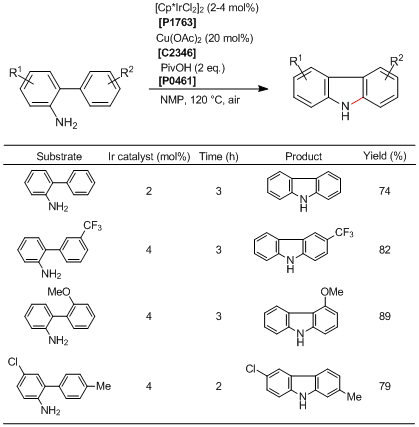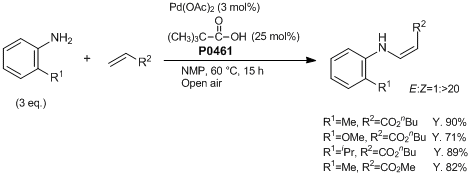Published TCIMAIL newest issue No.197
Maximum quantity allowed is 999
Merci de sélectionner la quantité
CAS RN: 75-98-9 | Numéro de produit: P0461
Pivalic Acid

Pureté: >99.0%(GC)
Synonymes
- 2,2-Dimethylpropionic Acid
- Trimethylacetic Acid
Documents de produit:
| Taille | Prix unitaire | Belgique | Japon * | Quantité |
|---|---|---|---|---|
| 25G |
€16.00
|
8 | ≥100 |
|
| 100G |
€24.00
|
8 | ≥100 |
|
| 400G |
€43.00
|
7 | 36 |
|
*Le délai de livraison pour des produits disponibles en stock en Belgique est 1 à 2 jours
*Le délai de livraison pour des produits disponibles en stock en Japon est 1 à 2 semaines (sauf des produits réglementés et des envois avec de la glace carbonique)
| Numéro de produit | P0461 |
| Pureté / Méthode d'analyse | >99.0%(GC) |
| Formule moléculaire / poids moléculaire | C__5H__1__0O__2 = 102.13 |
| Etat physique (20 ° C) | Solid |
| Condition de stockage | Room Temperature (Recommended in a cool and dark place, <15°C) |
| CAS RN | 75-98-9 |
| Numéro de registre de Reaxys | 969480 |
| Identifiant de la substance PubChem | 87574655 |
| SDBS | 3139 |
| Indice Merck (14) | 7511 |
| Numéro MDL | MFCD00004194 |
Spécifications
| Appearance | White or Colorless to Almost white or Almost colorless powder to lump to clear liquid |
| Purity(GC) | min. 99.0 % |
| Purity(Neutralization titration) | min. 98.0 % |
| Freezing point | 32.0 to 36.0 °C |
Propriétés
| Point de fusion | 34 °C |
| Point d'ébullition | 164 °C |
| solubilité dans l'eau | Slightly soluble |
| Degré de solubilité dans l'eau | 25 g/l 20 °C |
SGH
| Pictogramme |



|
| Mot de signal | Danger |
| Mentions de danger | H302 + H312 : Nocif en cas d'ingestion ou de contact cutané. H314 : Provoque des brûlures de la peau et de graves lésions des yeux. H371 : Risque présumé d'effets graves pour les organes. H290 : Peut être corrosif pour les métaux. |
| Conseils de prudence | P260 : Ne pas respirer les poussières. P280 : Porter des gants de protection/ des vêtements de protection/ un équipment de protection des yeux/ du visage/ auditive. P303 + P361 + P353 : EN CAS DE CONTACT AVEC LA PEAU (ou les cheveux): Enlever immédiatement tous les vêtements contaminés. Rincer la peau à l'eau. P301 + P330 + P331 : EN CAS D'INGESTION: Rincer la bouche. NE PAS faire vomir. P304 + P340 + P310 : EN CAS D’INHALATION: transporter la personne à l’extérieur et la maintenir dans une position où elle peut confortablement respirer. Appeler immédiatement un CENTRE ANTIPOISON/un médecin. P305 + P351 + P338 + P310 : EN CAS DE CONTACT AVEC LES YEUX: Rincer avec précaution à l'eau pendant plusieurs minutes. Enlever les lentilles de contact si la victime en porte et si elles peuvent être facilement enlevées. Continuer à rincer. Appeler immédiatement un CENTRE ANTIPOISON/un médecin. |
Lois connexes:
| Numéros CE | 200-922-5 |
| RTECS # | TO7700000 |
Informations de transport:
| Numéro UN | UN3261 |
| Classe | 8 |
| Groupe d'emballage (DOT-AIR) | II |
| N ° SH (import / export) (TCI-E) | 2915907098 |
Application
Synthesis of N―H Carbazoles via Ir-catalyzed Intramolecular C―H Amination

Typical Procedure:
To a 20 mL two-necked flask with a reflux condenser and a rubber cap are added 2-aminobiphenyls (0.5 mmol), [Cp*IrCl2]2 (0.01 mmol, 8.0 mg), Cu(OAc)2 (0.1 mmol, 18 mg), pivalic acid (1 mmol, 102 mg), 1-methylnaphthalene (ca. 30 mg) as an internal standard, and N-methyl-2-pyrrolidone (NMP, 3 mL). Then, the resulting mixture is stirred under air at 120 °C for 3-6 h. After cooling, the reaction mixture is extracted with ethyl acetate (100 mL). The organic layer is washed by aqueous NaHCO3 (100 mL×3), and dried over Na2SO4. After evaporation of the solvents under vacuum, the product is isolated by column chromatography on silica gel using hexane-ethyl acetate (10:1) as the eluent.
To a 20 mL two-necked flask with a reflux condenser and a rubber cap are added 2-aminobiphenyls (0.5 mmol), [Cp*IrCl2]2 (0.01 mmol, 8.0 mg), Cu(OAc)2 (0.1 mmol, 18 mg), pivalic acid (1 mmol, 102 mg), 1-methylnaphthalene (ca. 30 mg) as an internal standard, and N-methyl-2-pyrrolidone (NMP, 3 mL). Then, the resulting mixture is stirred under air at 120 °C for 3-6 h. After cooling, the reaction mixture is extracted with ethyl acetate (100 mL). The organic layer is washed by aqueous NaHCO3 (100 mL×3), and dried over Na2SO4. After evaporation of the solvents under vacuum, the product is isolated by column chromatography on silica gel using hexane-ethyl acetate (10:1) as the eluent.
References
Application
Pd-Catalyzed Z-Selective Oxidative Amination of Olefins

Typical Procedure:
A mixture of butyl acrylate (128 mg, 1.0 mmol) and o-toluidine (322 mg, 3.0 mmol) is allowed to react with Pd(OAc)2 (6.7 mg, 0.03 mmol, 3 mol%) and pivalic acid (26 mg, 0.25 mmol) in NMP (0.5 mL) at 60 °C for 15 h under open air in a 30 mL round-bottomed flask. The crude reaction mixture is cooled to room temperature. EtOAc (30 mL) is added to the dark solution. The residue is purified by column chromatography on silica gel (EtOAc : Hexane = 1 : 40) to provide (Z)-butyl 3-(o-tolylamino)acrylate (210 mg, Y. 90%).
A mixture of butyl acrylate (128 mg, 1.0 mmol) and o-toluidine (322 mg, 3.0 mmol) is allowed to react with Pd(OAc)2 (6.7 mg, 0.03 mmol, 3 mol%) and pivalic acid (26 mg, 0.25 mmol) in NMP (0.5 mL) at 60 °C for 15 h under open air in a 30 mL round-bottomed flask. The crude reaction mixture is cooled to room temperature. EtOAc (30 mL) is added to the dark solution. The residue is purified by column chromatography on silica gel (EtOAc : Hexane = 1 : 40) to provide (Z)-butyl 3-(o-tolylamino)acrylate (210 mg, Y. 90%).
References
PubMed Litterature
Articles / Brochures
TCIMail
[Research Articles] Synthesis of N-H Carbazoles via Ir-catalyzed Intramolecular C-H Amination[Research Articles] Pd-Catalyzed Z-Selective Oxidative Amination of Olefins
Documents de produit (Note : Pour certains produits, les tableaux analytiques ne sont pas disponibles.)
Fiche de sécurité (FDS)
S'il vous plaît sélectionnez la langue.
La FDS demandée n'est pas disponible.
Nous contacter pour plus d'informations.
Spécifications
CoA et autres Certificats
Veuillez remplir le numéro de lot
Le numéro de lot saisi est incorrect. Veuillez saisir uniquement 4-5 caractères alphanumériques avant le trait d'union.
Exemple de CoA
Il s'agit d'un échantillon CoA qui peut ne pas représenter un lot récemment fabriqué du produit.
Un échantillon CoA pour ce produit n'est pas disponible pour le moment.
Graphiques analytiques
Veuillez remplir le numéro de lot
Le numéro de lot saisi est incorrect. Veuillez saisir uniquement 4-5 caractères alphanumériques avant le trait d'union.
Le tableau analytique demandé n'est pas disponible. Nous sommes désolés pour ce désagrément.





